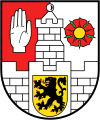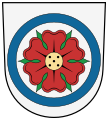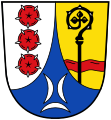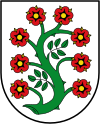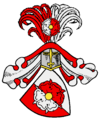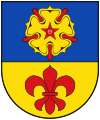Rose (heraldry)
The heraldic rose , even crest Rose is in heraldry non- common figure , the stylized flowering of the Five-petalled wild rose was modeled. The model of the heraldic rose, as it appears in the coats of arms of the primeval nobility, is the wild rose or dog rose with five petals of equal size. The reasons for the heraldic use of the rose lie in the symbolism as a "flower" of love, joie de vivre, happiness. The reputation of the flower as a symbol of the gods of pleasure ( Bacchus ) and love ( Venus , Aphrodite ) in antiquity made it appear as a vicious flower of eroticism in late antiquity and early medieval Christianity. Even in the sensually obscene festivals of the goddess Flora in ancient Rome, roses were carried through the streets. The rose was associated with the female genitalia and menstruation (monthly rose, female rose ). The rose is one of the preferred shield figures among the Germanic peoples.
In the course of the Middle Ages the rose appeared in Christian iconography as a symbol ( Rosa mystica ), as an invocation of Our Lady or as a model for the large Gothic rose windows. In its double version, the rose became a symbol of secrecy and secrecy (“sub rosa dictum”). The rose is represented in this context on the vault stones of old monasteries and town halls as well as on confessionals.
presentation
The heraldic figure shows an open flower when viewed from above. Natural roses are not depicted in heraldry. The rose is depicted with one sepal down and one petal up (the five petals 1: 2: 2), otherwise it is overturned . The petals are normal red, the sepals green (tipped green) , in the description of the coat of arms only other colors and the absence of the latter are reported (unadorned, unbeaten) - the petals are always tinged in the heraldic colors. The center of the flower is also known as a clump , button or roach . This ovule in the middle is, in contrast to the petals, often tinged with gold , that is, colored ( gold trimmed ). Sometimes it is surrounded by a differently or identically tinged, five-pointed calyx; inseminated is heraldically correct, botanically incorrect. The heraldic rose is sessile, it appears, it will bestielt and making any beblattet called, is possible in natural colors green for brown /, otherwise the color. The shape of the petals with mostly rolled up outer edges is often different and subject to the respective fashion of historical heraldry. In the earliest traditional forms, the leaves are rounded or slightly heart-shaped. In later phases the petals taper off in slight tips. The preferred color of the flowers is red, gold or silver is also used occasionally.
If a natural rose is represented in the coat of arms, then as a branch, wreath, bouquet or stylized perennial. Such representations are among the earliest floral heraldic figures. Shield fields and helmet covers can be sown or sprinkled with small roses. Heraldic figures, helmet decorations and auxiliary regalia can be decorated with roses. On closer examination, there are sometimes many individual flowers in a rose-like representation other flowers. In the confusingly similar loquat flower , however, the petals and sepals are much slimmer and more pointed. In the case of the five-leaf (graphic composition of five leaves, sometimes also pierced), the middle section of a usual rose is missing. The blue “roses” in non- speaking coats of arms probably show flax blossoms . The basic rules of heraldry are contradicted by rosaries as a substitute for helmet covers, ornamental work of rose petals used purely for ornamental purposes in the newly awarded noble coats of arms with crowns and roses in late baroque and classicist women's coats of arms.
variants
The number of petals can - botanically incorrect - be four or six. Sometimes eight sheets are also in use. Roses with four, six or eight petals are rarer in heraldry. An intended number symbolism can be assumed. Rose coats of arms that differ from the five are to be mentioned in the description. This is also true if the rose has more than just a wreath of petals. Often several circles of petals are placed on top of one another, decreasing in size, with the same tinging. This rose is then filled two or more times . Occasionally the sheets are also rolled, which has to be reported.
- With the Tudor rose , the white is superimposed on the red. It is of historical importance.
- The medlar flower (Geldernsche Rose) differs in number five by the pointed petals.
- The Luther rose comes from Protestant heraldry
Examples of heraldic roses
A fine example of heraldic roses are the five branches of the Bohemian Wittigonen house :
- from Haus Rosenberg , red rose, golden trimmed in silver
- from Haus Landstein , silver rose, golden trimmed in red
- from Haus Neuhaus , golden rose in blue
- by Aussig and Straze, blue rose, golden trimmed in gold
- by the Lords of Krumau ( Czech : Krumlov), unshaved, green rose, golden trimmed, in silver ( coat of arms )
In the upper coat of arms , the colors from the shield in the helmet covers and the rose on the umbrella board are repeated .
Lippe rose in the coat of arms of the Lippe district
and in the coat of arms of North Rhine-Westphalia
Rose of Lancaster
Rose of York
the Tudor rose
Reus coat of arms
Luther rose : a symbol of the Evangelical Lutheran Churches
Coat of arms of the city of Altenburg
Annaburg : rose bush with 3: 2 flowers
as in Ormesheim
Geldern rose in the coat of arms of Erkelenz
Mandelbachtal : two each in the corners of a paw cross
Penig coat of arms
Ringsheim coat of arms
Rödental coat of arms with elements of the Knights of Rosenau
Roosendaal coat of arms
Rosenheim coat of arms
Roßwag coat of arms
Rose branch with 8 flowers: Selfkant
Sontra with the Hessian lion
"Poppenburger Rose" in the Wennigsen (Deister) coat of arms
Coat of arms of the Guttenberg family
Family coat of arms of those of Trauttmansdorff with roses in confused colors
Coat of arms of the Poraj family
Trondheim city flag (eight-petalled rose)
Four-wheel coat of arms with a double rose and split sepals
Coat of arms St. Johann (Saar)
Coat of arms of Kevelaer : golden rose with a red, five-pointed slug and red sepals
Web links
Individual evidence
- ↑ Robert Markley: The BLV Rose Encyclopedia. 4th revised edition. blv, Munich 2005, ISBN 3-405-16676-4 , pp. 18-19.
- ↑ Dr. Bernhard Peter: "The heraldic rose."
- ^ Walter Leonhard : The great book of heraldic art. Development, elements, motifs, design. 2nd, revised and expanded edition. Georg DW Callway, Munich 1978, ISBN 3-7667-0345-5 , pp. 13, 16, 32, 84, 92 f., 127, 148, 171, 177, 180, 245, 25 4 f., 258, 365.
- ↑ Robert Markley: The BLV Rose Encyclopedia. 4th revised edition. blv, Munich 2005, ISBN 3-405-16676-4 , pp. 10-19.
- ^ Milan boys : Heraldry. Edited edition. Albatros, Prague 1986.
- ↑ Flag. (No longer available online.) Homepage of the City of Trondheim, archived from the original on September 23, 2007 ; Retrieved November 27, 2013 (Norwegian). Info: The archive link was inserted automatically and has not yet been checked. Please check the original and archive link according to the instructions and then remove this notice.









